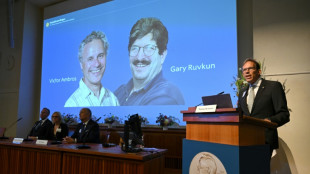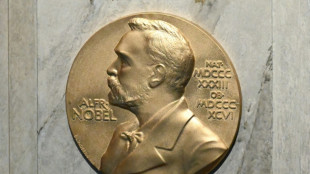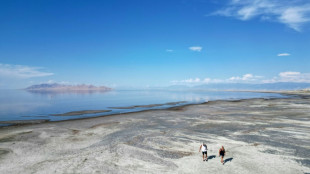-
 'Dark day': Victims mourned around the globe on Oct. 7 anniversary
'Dark day': Victims mourned around the globe on Oct. 7 anniversary
-
On attacks anniversary, Israel fights multi-front war

-
 Intensifying to Category 5, Hurricane Milton targets Florida
Intensifying to Category 5, Hurricane Milton targets Florida
-
Biden, Harris mark Oct. 7 with call for Mideast peace

-
 Dupont set for Toulouse return after post-Olympic holiday
Dupont set for Toulouse return after post-Olympic holiday
-
French rugby bosses tighten discipline after nightmare Argentina tour

-
 Visitors to get rare view of Rome's Trevi Fountain
Visitors to get rare view of Rome's Trevi Fountain
-
Man City and Premier League both claim victory in legal case

-
 Deschamps delight as 'light back on' for Pogba after doping ban
Deschamps delight as 'light back on' for Pogba after doping ban
-
Biden, Harris urge Mideast peace on Oct. 7 anniversary

-
 Neeskens, tough midfielder in Cruyff's Ajax and Dutch teams
Neeskens, tough midfielder in Cruyff's Ajax and Dutch teams
-
UN warns world's water cycle becoming ever more erratic

-
 Oil prices extend gains on Mideast tensions, Wall Street retreats
Oil prices extend gains on Mideast tensions, Wall Street retreats
-
Ex-Dutch football star Johan Neeskens dies

-
 Man Utd battling to improve fortunes, says Evans
Man Utd battling to improve fortunes, says Evans
-
What is microRNA? Nobel-winning discovery explained

-
 Masood, Abdullah centuries lift Pakistan to 328-4 in first England Test
Masood, Abdullah centuries lift Pakistan to 328-4 in first England Test
-
Hurricane Milton strengthens fast, threatens Mexico, Florida

-
 Tunisia's President Saied set for landslide election win
Tunisia's President Saied set for landslide election win
-
Barca hoping to return to Camp Nou 'by end of year'

-
 Trump to open second golf course at Scotland resort in summer 2025
Trump to open second golf course at Scotland resort in summer 2025
-
Super-sub Jhon Duran rewarded with new Aston Villa deal

-
 US duo win Nobel for gene regulation breakthrough
US duo win Nobel for gene regulation breakthrough
-
Masood hits first ton for four years to power Pakistan to 233-1

-
 Fritz wins delayed match to reach Shanghai Masters third round
Fritz wins delayed match to reach Shanghai Masters third round
-
Naomi Osaka pulls out of Japan Open with back injury

-
 China to flesh out economic stimulus plans after bumper rally
China to flesh out economic stimulus plans after bumper rally
-
Artist Marina Abramovic hopes first China show offers tech respite

-
 Pakistan 122-1 at lunch in first England Test
Pakistan 122-1 at lunch in first England Test
-
Kazakhs approve plan for first nuclear power plant

-
 World marks anniversary of Oct. 7 attack on Israel
World marks anniversary of Oct. 7 attack on Israel
-
'Second family': tennis stars hunt winning formula with new coaches

-
 Philippines, South Korea agree to deepen maritime cooperation
Philippines, South Korea agree to deepen maritime cooperation
-
Mexico mayor murdered days after taking office

-
 Sardinia's sheep farmers battle bluetongue as climate warms
Sardinia's sheep farmers battle bluetongue as climate warms
-
Japan govt admits doctoring 'untidy' cabinet photo

-
 Israel marks first anniversary of Hamas's October 7 attack
Israel marks first anniversary of Hamas's October 7 attack
-
Darvish tames Ohtani as Padres thrash Dodgers

-
 Asian markets track Wall St rally on jobs data
Asian markets track Wall St rally on jobs data
-
Family affair as LeBron, Bronny James make Lakers bow

-
 Cancer, cardiovascular drugs tipped for Nobel as prize week opens
Cancer, cardiovascular drugs tipped for Nobel as prize week opens
-
As Great Salt Lake dries, Utah Republicans pardon Trump climate skepticism

-
 Amazon activist warns of 'critical situation' ahead of UN forum
Amazon activist warns of 'critical situation' ahead of UN forum
-
Mourners pay tribute to latest victims of deadly Channel crossing

-
 Phillies win thriller to level Mets series
Phillies win thriller to level Mets series
-
Yu bags first PGA Tour win with playoff win

-
 PSG held by Nice to leave Monaco clear at top of Ligue 1
PSG held by Nice to leave Monaco clear at top of Ligue 1
-
Lewandowski treble for leaders Barca as Atletico held

-
 Fresh Israeli strikes hit south Beirut
Fresh Israeli strikes hit south Beirut
-
Sucic stunner earns Real Sociedad draw against Atletico

| RBGPF | -1.97% | 58.94 | $ | |
| CMSC | -0.2% | 24.65 | $ | |
| SCS | -0.7% | 12.88 | $ | |
| BCC | 0.48% | 139.569 | $ | |
| GSK | 0.06% | 38.845 | $ | |
| NGG | -1.28% | 65.66 | $ | |
| BCE | -0.33% | 33.6 | $ | |
| RIO | -0.13% | 69.61 | $ | |
| BTI | -0.02% | 35.284 | $ | |
| RYCEF | -1.45% | 6.88 | $ | |
| RELX | -0.6% | 46.015 | $ | |
| JRI | -0.38% | 13.23 | $ | |
| CMSD | -0.09% | 24.79 | $ | |
| BP | 0.74% | 33.125 | $ | |
| AZN | -0.36% | 77.19 | $ | |
| VOD | 0.21% | 9.68 | $ |
Europe's asteroid mission Hera launches despite hurricane
Europe's Hera probe launched Monday on a mission to inspect the damage done by a NASA spacecraft when it smashed into an asteroid during the first test of Earth's planetary defences.
Despite fears that an approaching hurricane could delay the launch, the probe blasted off on a SpaceX rocket into cloudy skies from Cape Canaveral in the US state of Florida just before 11:00 am local time (1500 GMT).
Hera's mission is to investigate the aftermath of NASA's Double Asteroid Redirection Test (DART), which deliberately crashed into the Dimorphos asteroid in 2022 roughly 11 million kilometres (6.8 million miles) from Earth.
The fridge-sized DART spacecraft successfully knocked the asteroid well off course, demonstrating that humanity may no longer be powerless against potentially planet-killing asteroids that could head our way.
The European Space Agency (ESA) said the Hera craft will investigate what it has called the "crime scene" in the hopes of learning how Earth can best fend off future space rocks.
The launch was met with applause from teams on the ground, according to an ESA broadcast.
Poor weather ahead of Hurricane Milton had put the launch into doubt, with SpaceX warning on Sunday that there was only a 15 percent chance of a launch.
Milton is the latest hurricane to hit the Gulf of Mexico after the deadly Hurricane Helene. It has been classified as "an extremely dangerous category 4 hurricane" and is expected to slam into Florida in the coming days.
- Green light after 'mishap' -
The launch had also faced a potential delay due to an anomaly involving a Falcon 9 rocket during the launch of SpaceX's Crew-9 astronaut mission late last month.
But on Sunday, the US Federal Aviation Administration gave the green light.
Hera is planned to fly past Mars next year and then arrive near Dimorphos in December 2026 to begin its six-month investigation.
Dimorphos, which is actually a moonlet orbiting its big brother Didymos, never posed a threat to Earth.
After DART's impact, Dimorphos shed material to the point where its orbit around Didymos was shortened by 33 minutes -- proof that it was successfully deflected.
But much about the impact remains unknown, including how much damage was done and exactly what the asteroid -- which is about the size of an Egyptian pyramid -- was like before it was hit.
Analysis of the DART mission has suggested that rather than being a single hard rock, Dimorphos was more a loose pile of rubble held together by gravity.
"The consequence of this is that, instead of making a crater" on Dimorphos, DART may have "completely deformed" the asteroid, the Hera mission's principal investigator Patrick Michel told a press conference.
But there are other possibilities, he said, adding that the behaviour of these low-gravity objects is little understood and "defies intuition".
- 'Able to protect ourselves' -
An asteroid wider than a kilometre (0.6 miles) -- which could trigger a global catastrophe on a scale that wiped out the dinosaurs -- is estimated to strike Earth every 500,000 years or so.
An asteroid around 140 metres (460 feet) wide -- which is a little smaller than Dimorphos but could still take out a major city -- hits our home planet around every 20,000 years.
Most of these celestial objects come from the asteroid belt between Mars and Jupiter. Almost all those bigger than a kilometre wide are known to scientists, and none are expected to threaten Earth in the next century.
There are also no known 140-metre asteroids on a collision course with Earth -- but only 40 percent of those space rocks are believed to have been identified.
Although asteroids are one of the least likely natural disasters to strike the planet, people now have the "advantage of being able to protect ourselves against them", the Hera mission's principal investigator Patrick Michel said.
The 363-million-euro ($400 million) mission will be equipped with 12 scientific instruments and two nanosatellites.
Once its job is done, the team on the ground hope that Hera can land gently on Dimorphos or Didymos, where it will spend the rest of its days.
H.Silva--PC
